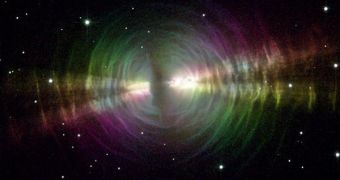A stellar remnant located more than 30,000 light-years away from the Earth is currently emitting flares and bursts of radiation so powerful, that it has astronomers looking at it day and night. Up until just recently, NASA experts had no idea as to why exactly did this star throw out so many ejections, and, more specifically, failed to understand what its power source was. However, astrophysicists have now managed to conclude that the engine behind these unusual manifestations is a rare and very special type of neutron star, called a soft-gamma-ray repeater, of which only 6 bodies have been identified so far.
“At times, this remarkable object has erupted with more than a hundred flares in as little as 20 minutes. The most intense flares emitted more total energy than the sun does in 20 years,” Pennsylvania State University Swift observations coordinator Loredana Vetere, who has been part of the team that used the Swift satellite and the Fermi Gamma-ray Space Telescope for observing the distant stellar formation, says. The object, which is located in the Norma southern constellation, has been under surveillance for the last two years, and astronomers already know it's an important source of pulsing radio and X-ray signals.
The most important thing about SGR J1550-5418, the codename the remnant has received, is that it's a magnetar, a type of neutron star that has a magnetic field about 1,000 times stronger than the usual one. Even though these celestial bodies only measure 12 miles in diameter, astrophysicists estimate that they hold as much mass in them as the Sun, which implies that their gravitational pull is huge. And therein lies the solution to the source dilemma. NASA experts hold that the star most likely draws its energy from its own magnetic field, and releases it as bursts over short periods of time.
“The ability of Fermi's gamma-ray burst monitor to resolve the fine structure within these events will help us better understand how magnetars unleash their energy,” NASA astrophysicist Chryssa Kouveliotou, from the Marshall Space Flight Center in Huntsville, Alabama, adds.
“X-rays from the brightest bursts scatter off of dust clouds between us and the star. As a result, we don't really know the distance to this object as well as we would like. These images will help us make a more precise measurement and also determine the distance to the dust clouds,” Columbia University expert Jules Halpern, who was the first to use Swift's X-ray telescope to detect “light echoes” from the formation, explains.

 14 DAY TRIAL //
14 DAY TRIAL //